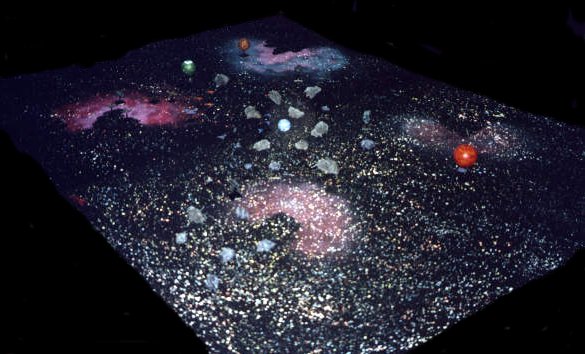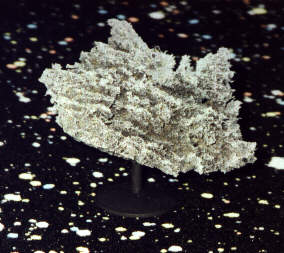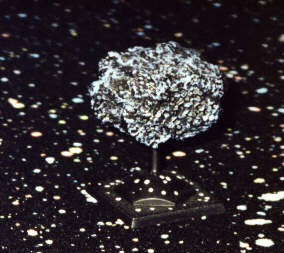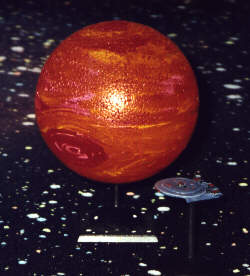

'Schild en Vriend' is an old Flemish battlecry, used in the rebellion of the city of Brugge against the French, May 18, 1302. Legend tells that it was used to differentiate between the French-speaking (who could not pronounce 'schild') and Flemish-speaking citizens. Nowadays, historians tell us that it was probably 'Des Gilden Vriend'.

Full Thrust
|

|
| Deep space with the starscape mats. Asteroids and planets are scratch-built (see below). Note: this picture has no transparent colors, so everything you see on it is on the mats, not part of the background of the page. |
A space game without asteroids is like Boris Jeltsin without vodka: interesting for a while, but the novelty quickly wears off. Having asteroids or other interplanetary bodies on the table introduces an extra factor in maneuvring your ships: should you steer a wide path around them and loose their protective value, or steer close enough to profit from their line-of-fire blocking, yet risk running into one? Add the possiblity of moving asteroid fields, and you come up with an entirely different game.
Below are two ways we have used to make asteroids:
The sponge asteroid
 | These asteroids were made by taking a natural sponge and ripping it into irregular pieces. A synthetic sponge would probably work just as well, but it is a lot easier to get the irregular look wanted with a natural one. The soon to be asteroids were then dyed black by soaking them in diluted textile paint. This turned out to be more of a bother than expected, because they had to be turned over several times while they were drying to prevent the paint from collecting in one area of the sponge. It had probably been a lot easier to just spray paint the things black. After the sponges had dried completely, they were sprayed them from a considerable distance with white spray paint, to give the whole thing some contrast. The asteroids were then mounted on a flying stand and were ready to be used. A sponge the size of two balled fists got me about twelve asteroids this way.
Note: the asteroid pictured on the left turned out to be quite bright for some reason (probably got too close with the camera's flash). The actual asteroids are somewhat darker with more contrast between white and black. |
The styrofoam asteroid
 |
The material used in making these asteroids was styrofoam (expanded polystyrene, the white beady kind). Blocks of styrofoam were ripped into vaguely asteroid shaped pieces, occasionaly helped by 'eating away' bits of styrofoam using super glue (cynaoacrylate - don't inhale the fumes produced, or if you do, don't blame us, and be nice to the purple bunnies you'll see (-: ). The resulting asteroid shapes were then painted black and drybrushed in successively lighter shades of grey.
Note: the asteroid pictured on the left turned out to be quite bright for some reason (probably got too close with the camera's flash). The actual asteroids are somewhat darker with more contrast between white and black. |
A word on scale
As you'll notice, our planets are hardly to scale: some of our model ships are bigger then our model planets, but even if you take into account the usual difference between miniature and ground scales in most miniature wargames, they still turn out to be several orders of magnitude too small. This is done deliberately for two reasons: for one, you try to find a globular object the correct scale size that is still manageable, and two - the most important reason - this makes the planets manageable in game terms. Using the standard FT rules for orbits (distance from the planet model and orbiting speed is equal to planet model's diameter in inches) leads to nicely manageable speeds for orbiting ships and usually forces a ship approaching orbit to slow down instead of hitting orbit at quite insane speeds. This in turn forces the player wanting to send ships into orbit to devote some attention to tactics, as slowing down a ship makes it's flight path more predictable and thus makes the ship more vulnerable. Then again, this is just our opinion, so feel free to make your planets as big as you want.
Construction
 | In our case, making the planets turned out to be a doddle. We found a craft shop that sells styrofoam globes in several sizes, ranging from 1 inch up to 10 inches or so. These globes were then painted in various colours to represent Earth-type or other planets, such as this orange Jupiter lookalike (ship included for scale reference). Other variations include eating away parts of the styrofoam with cyanoacrylate glue (say hi to the bunnies) to simulate tectonically super-active (lots of volcanoes and planetquakes) or seriously battle scarred planets. Rings, such as Saturn's, can be created using individual little styrofoam chunks or other materials such as kitty litter, glued to small pieces of black painted wire poked into the styrofoam planet, or to a clear plastic ring around the planet.
Other materials that can be used to create planets include ping pong balls for the smaller planets, tennisballs with the 'grooves' filled in using some kind of filler, etc. |

Home | This page is maintained by Bart Vetters Schild en Vriend Miniature Wargaming Club Leuven |